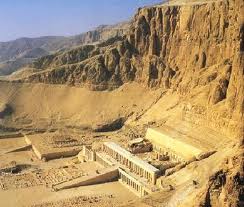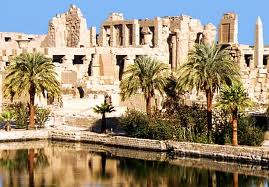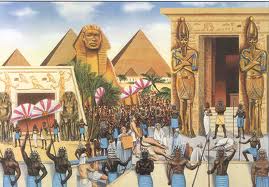- Civilization in Egypt began around 3,100 BCE and lasted approximately 3,500 years.
- Egyptologists have been uncovering the ruins and artifacts, deciphering inscriptions, and restoring monuments of ancient Egypt for centuries.
- 13th Century BCE – Khaemwese was the first Egyptologist (son of Ramses II).
- Ancient Egypt is much more than just Pharaoh, pyramids, elaborate burials, and curses.
- Many historians suffer from “tunnel vision” – grandeur of monuments overshadows the people and society.
- The study of ancient Egypt is ongoing – with each new discovery comes new questions and theories about ancient Egyptian civilization and life.
The Geography of Egypt
- Isolated and protected by deserts on all sides.
- Inhospitable environment of the desert protected Egypt from invasion and from outside influences.
- Slow, isolated development – stability was the goal; change was done slowly and with caution.
The Nile River
- Developed around a great river system – the Nile River.
- Extremely fertile due to annual, predictable flooding.
- Was a lifeline – provided water, silt, natural highway.
- Nile Delta – area where the Nile empties into the Mediterranean Sea; largest area of fertile land.
- Lived on the eastern side; buried the dead on the western side.
Red Land, Black Land
- Red Land (deshret) – dead (unfertile) sands of the surrounding desert; the “forbidden” territory; houses many minerals (gold, fine gems).
- Black Land (kemet) – rich silt soil along the bank of the Nile.
The Mediterranean
- Close access to the Mediterranean helped to increase and expand trade and culture.
Historical Overview
- Egypt began as two separate kingdoms: Upper and Lower Egypt.
- Upper – tall white crown
- Lower – red crown
- There are seven major periods:
- Predynastic Period
- Old Kingdom
- Middle Kingdom
- New Kingdom
- Late Dynastic Period
- Greek Period
- Roman Period
Historical Highlights
- UNIFICATON – upper and lower Egypt are unified; began 3000 years of ancient Egyptian civilization.
- AGE OF PYRAMIDS – began during the era of the Old Kingdom; evolved from mastabas, to step pyramids, to the true pyramid.
- NATIONAL GOD: AMON’RE – the god Amon was merged with the god Re, becoming the national god of Egypt, Amon-Re.
- EXODUS – Hebrew slaves in Egypt (under the reign of Ramses II) were led out of Egypt by Moses.
Predynastic Period
- 3100 to 2650 BCE (1st -2nd dynasty)
- 3100 BCE – war broke out between Upper and Lower Egypt, with Upper Egypt being triumphant.
- King Menes united the kingdoms, beginning the first Egyptian dynasty.
- Wore the double crown.
- Memphis named the capital.
- Developments:
- Hieroglyphics
- Irrigation system
Old Kingdom
- King (pharaoh) is considered to be a living god
– the supreme ruler of all affairs. - “Age of the Pyramids”
- A symbol of unlimited authority of Egyptian pharaohs.
- Step Pyramid at Saqqara (Djoser)
- Great Pyramids at Giza (Khufu/Cheops, Khafre/Chephrem, Menhure/Mycerinus)
- Imhotep – first vizier
- the founder of Egyptian system of medicine
- architect (space and design)
- only man who was not a pharaoh, yet recorded in history
- Developments:
- Hieroglyphics improve
- Farming and trade regulated
- Egypt divided into provinces/districts; governor appointed
- FIRST INTERMEDIATE PERIOD (2143 to 2040 BCE)
- A time of general disorder and anarchy (about 150 years).
- Began after the death of Pepi II.
- No strong king able to control entire territory.
- Many were competing for power and trying to form own dynasty (7th to 10th Dynasty).
- Memphis falls into a state of neglect.
Middle Kingdom
- 2040 to 1640 BCE (11th to 12th dynasty)

- Egypt was reunited by Theban kings of the 11th Dynasty and began to prosper again.
- Local governors still posed a threat.
- Developments:
- Amon-Re becomes the national god
- Trade links rebuilt
- Creation of fine crafts
- Interest in learning was renewed
- Architecture, literature, and arts flourished
- Hyksos introduced horse-drawn chariots, copper arrowheads, daggers, curved-blade sword, and compound bow
- SECOND INTERMEDIATE PERIOD (1640 to 1550 BCE)
- AKA: The Hyksos Invasion
- Period of time where Egypt was controlled by foreign rulers (Hyksos Kings).
- “Rulers of foreign land”
- The Hyksos were a warlike people from areas now known as Syria and Palestine.
- While Egypt was culturally superior, they lagged behind in technology
- The superior technology of the Hyksos enabled them to take over Egypt.
- Once Egyptians were able to master new technology and weapons, they were able to drive the Hyksos out of Egypt.
The New Kingdom
- 1550 to 1070 BCE (18th to 20th Dynasty)

- Pharaohs were fearless, tireless, strong, and invincible.
- Egypt would never fall to foreign hands again
- Stronger, larger standing armies
- Expanded Egyptian empire
- Religious revolution under Amenhotep (Akhenaton)
- The Amarna Revolution
- Developments:
- Leather body armour covered with medal scales
- Charioteers carried large shields
- Foreign trade is extended
- SOME IMPORTANT PEOPLE…
- Hatshepsut
- Powerful female pharaoh (one of four)
- Stepmother and regent to Tuthmosis III (rightful heir)
- Rebuilt Egypt’s trade network
- Tuthmosis III
- A military genius – “Napoleon of Egypt”
- Amarna Revolution – made the sun god Aton the only recognized
god of Egypt (polytheistic to monotheistic)
- Tutankhamun (Tutankhaton): Son of Akehaton; took power at age 9 or 10 (the boy king)
- Restores the old religion of Egypt
- Discovery of his tomb renewed people’s interest in ancient Egypt
- Horemheb: Repudiates the religion of Akhenaton
- Ramses II: Rules as empire crumbles under pressure from the Hittites
- Believed to be the pharaoh who reigned during Exodus
The Late Dynastic Period
- 1070 to 332 BCE
- Bitter struggles for power increased among priests and nobles.
- Egypt broke up into a number of small states.
- Lost territory abroad.
- Weakness attracted invaders
- Egypt is invaded and dominated by a series of groups: Nubia, Assyria, Saite, Persia.
The Greek Period
- 332 to 48 BCE
- Egyptians resented Persia’s occupation.
- Revolts and opposition were frequent.
- 332 BCE: Alexander the Great (Macedonia) conquers Persia and takes control of Egypt.
- Alexandria was founded.
- After Alexander the Great’s death, Ptolemy I ruled Egypt.
- Greek culture was spread – temples built to Greek gods.
The Roman Period
- 48 BCE to 395 CE
- Cleopatra VII and her brothers wrangled for power and drew the attention of Rome.
- Cleopatra eventually formed alliances with Julius Caesar and Mark Antony.
- Egypt became a territory of Rome upon the suicide of Cleopatra and Mark Antony.
- Roman law was introduced
- Iron weapons and tools, clear glass, terra-cotta lamps, lathe, split-nib pen, key, ox-drawn waterwheel, threshing machine
- By 642 CE, Egypt was conquered by Muslims from Arabia.

